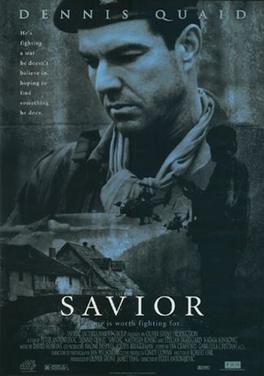“Savior” is another movie set in
the Bosnian War. In fact, it was the
first movie shot in Serbia after the war ended.
Director Predrag Antonijevic, who was a political prisoner during the
war, attempted to bring the dysfunctional nature of the war to Western
audiences. To gin up interest, the movie
stars Dennis Quaid.
Quaid plays Joshua Rose. Joshua is a State Department official
stationed in Paris. His wife (the
second-billed Natassja Kinski) is killed by Islamic terrorists before Kinski’s name
appears in the credits. Joshua responds in
a human way by going to a mosque and opening fire on Muslims. Then it’s off to a new life and new name
(Guy) in the French Foreign Legion. Six
years pass and he is a mercenary sniper for the Bosnian Serbs. He lives to kill Muslims and Bosnia in 1992
is the best place in the world to do that.
He is soulless and does not shirk from shooting kids. He would be unredeemable if this was not a
movie. In a bombed out town, he and his Bosnian
partner Goran encounter a Serbian woman named Vera (Natasa Ninkovic). She has been impregnated by a Muslim soldier
which means Bosnian Serb men consider her to be dishonored. Guy regains his humanity and starts his
redemption arc when he saves Vera from being murdered by his partner. He then delivers the baby. At this point the movie becomes a road
picture and a chase film. Guy and Vera’s
odyssey to a safe zone brings them into contact with the type of characters you
find in a civil war. They are helped at
one point by an old Serbian/Croat couple.
The old man sums up the war: “I am Croat, my wife Serb. Before the war – no difference. Now… stupid”.
The chase involves Goran’s vendetta-minded relatives (assisted by Vera’s
father). Through this hellscape, Guy and
Vera bond, of course. If you think they
are going to get married and live happily ever after, think again.
“Savior” is a grim movie that
informs an American audience about the mess that was the Bosnian War. Quaid’s participation brought it some
recognition, but the brutally honest take on the war was not exactly box office
magic. Quaid is excellent as the broken
Joshua. He behaves the way I could see
myself behaving given what happens to his wife.
The redemption cliché is stale, but necessary. Natasa Ninkovic holds her own. She won several best actress awards at various
festivals. There is chemistry between
the leads, but thankfully the movie is not a traditional romance. There are some despicable villains including
a Chetnik leader who carries medieval weapons in a golf bag. There are some powerful scenes, none more
gut-wrenching than when that villain massacres a group of civilians while Guy
watches in hiding with the baby. The
movie is not without flaws. It tends to
get melodramatic is spots. It is
sometimes difficult to tell the Serbs from the Croats (but maybe that was
intentional for a war that had no good guys).
And it has a weird and unsatisfying ending.
Will it crack the 100 Best War
Movies? Nope, but it is not a bad movie
and deserves a watch. Especially if you
have not seen a movie about the Bosnian War.
GRADE = B


